Chandor Gardens
From a Master Gardner who grew up next door, this is the bigger picture.
“I love the sunny skies of Texas but I want to see her open prairies dotted with gardens-streams and flowers. That’s why I worked out this garden in my mind before we built our home here in Weatherford. We planned the garden first, then snuggled a house into it.” These words could have been spoken by hundreds of gardeners in Texas but world-renowned portrait artist, Douglas Chandor, spoke them as he recounted the reason for creating his garden, WHITE SHADOWS. He was one of the most famous portrait artists of his time. He painted approximately 300 portraits including Winston Churchill, President Franklin Roosevelt, Eleanor Roosevelt (the only portrait ever painted of her), President Herbert Hoover, Sam Rayburn and his last portrait was of Queen Elizabeth II. His portraits of Presidents Hoover and Roosevelt and Prime Minister Winter Churchill are among the five of his paintings exhibited in the Smithsonian’s National Portrait Gallery. Douglas Chandor came to this country in 1926 and married Ina Kuteman in 1934. This handsome transplanted Englishman created a Chinese Garden of Eden on ground of caliche and a bed of matted shells, hard as concrete. Dynamite, picks, shovels, mules and elbow grease were the tools that helped Chandor create his vision. A garden tribute to his wife Ina a driving force for Douglas as he created this oasis in the unforgiving Texas weather. In sixteen years, (1936 till his death January 13, 1953) a garden legacy was left that was rivaled only by the beauty he created in his portraits. When asked about his passion for gardening, Douglas would reply that he was given the skills to paint in order to build his garden. As a tribute to her husband, Ina changed the name to Chandor Gardens and kept the gardens open to the public until 1978 when she passed away.
Projects
Portraits including Winston Churchill, President Franklin Roosevelt, Eleanor Roosevelt (the only portrait ever painted of her), President Herbert Hoover, Sam Rayburn and his last portrait was of Queen Elizabeth II. His portraits of Presidents Hoover and Roosevelt and Prime Minister Winter Churchill are among the five of his paintings exhibited in the Smithsonian’s National Portrait Gallery. Douglas Chandor came to this country in 1926 and married Ina Kuteman in 1934. This handsome transplanted Englishman created a Chinese Garden of Eden on ground of caliche and a bed of matted shells, hard as concrete. Dynamite, picks, shovels, mules and elbow grease were the tools that helped Chandor create his vision. A garden tribute to his wife Ina a driving force for Douglas as he created this oasis in the unforgiving Texas weather. In sixteen years, (1936 till his death January 13, 1953) a garden legacy was left that was rivaled only by the beauty he created in his portraits. When asked about his passion for gardening, Douglas would reply that he was given the skills to paint in order to build his garden. As a tribute to her husband, Ina changed the name to Chandor Gardens and kept the gardens open to the public until 1978 when she passed away.
The gardens fell into a tragic state of disgrace after the death of Douglas and later Ina. Melody and Chuck Bradford left their ranch in Aledo to rescue this tarnished jewel of Weatherford. Like Sleeping Beauty, the gardens have awakened to the delight of everyone who walks through the beautiful ornate iron gates. The Bradfords spared no expense to breathe new life into the gardens Douglas loved so passionately.
It is a delight to see what the Bradfords accomplished beginning in 1994, when they assumed ownership of the 16½ acre garden. Approximately 3½ acres are developed in the Gardens, and they had thoughts of creating nature trails with the rest of the property. The Gardens were purchased by the City of Weatherford in the spring of 2002 and with some modification (parking lot, additional restrooms and making parts of the Gardens ADA approved) the Gardens were opened again to the public.
It is wonderful that the Bradfords have brought a once beautiful garden back to the splendor of its glory days. Parker County Master Gardeners now have the privilege of helping with maintenance, identification of plants, planning future projects, being a docent organization and sharing this treasure with others as we show what can be done on a barren caliche pallet.
The gardens fell into a tragic state of disgrace after the death of Douglas and later Ina. Melody and Chuck Bradford left their ranch in Aledo to rescue this tarnished jewel of Weatherford. Like Sleeping Beauty, the gardens have awakened to the delight of everyone who walks through the beautiful ornate iron gates. The Bradfords spared no expense to breathe new life into the gardens Douglas loved so passionately.
It is a delight to see what the Bradfords accomplished beginning in 1994, when they assumed ownership of the 16½ acre garden. Approximately 3½ acres are developed in the Gardens, and they had thoughts of creating nature trails with the rest of the property. The Gardens were purchased by the City of Weatherford in the spring of 2002 and with some modification (parking lot, additional restrooms and making parts of the Gardens ADA approved) the Gardens were opened again to the public.
It is wonderful that the Bradfords have brought a once beautiful garden back to the splendor of its glory days. Parker County Master Gardeners now have the privilege of helping with maintenance, identification of plants, planning future projects, being a docent organization and sharing this treasure with others as we show what can be done on a barren caliche pallet.
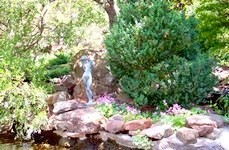
CHANDOR GARDENS
Douglas Chandor’s White Shadows
The Gardens were started in 1936.
There are approximately 16½ acres and about 3½ acres are developed. The garden has 8 water features.
The Simmons Street gates are original to the gardens.
Ina was unique too. She had a shotgun and would shoot at the armadillos and other varmints at night in the gardens. Often the silence of the Texas night was broken by the sound of Ina’s shotgun but it angered her for them to be destroying Douglas’ garden. Douglas died in 1953 at 52 years of age. Ina died in 1978 and the gardens closed to the public. He planned, designed and worked in his garden for less than 17 years, but what wonderful things he accomplished.
The Bradfords lived in Aledo for 25 years before moving to the gardens. Melody was from Natchez, Mississippi and Chuck is a Texan. The Bradfords bought the gardens in 1994 and busied themselves with the restoration of the gardens. The first year, they spent cleaning the place; the ponds had to be cleaned because there was no circulating system installed. It was dreadful. They brought in a septic service and men with picks and shovels to clean out the ponds. This took the crew several weeks of hard labor. The next procedure was to clear out all the weeds, dead trees and wisteria vines that had covered the grounds. They had to bring specialists to clean the remaining live trees of wisteria and mistletoe. The branches had to be cleaned and shaped. The gardens had been left unattended for over 20 years, so you can imagine that they had a lot of work to do. All the plants you see have been planted since 1995, except the older trees and the European Boxwood. A gardener and the Bradfords took care of the gardens on a daily basis. About every three to four weeks, they would bring in their landscaping crew to do major planting, mulching and feeding. They brought in bagged mulch on flatbed-eighteen wheelers. This garden was a costly project but as you see, it is now a place of beauty. The Bradfords remember coming to the gardens when they were children, long before they met each other. It saddened them to see what had once been a beautiful garden fall into a state of disgrace. It took them four visits before they decided to buy it and start the restoration. One time Melody wanted to buy it and Chuck said no, then one time Chuck wanted to buy it and Melody said no. A third visit was made with no decision then on the fourth visit, they decided to buy the property. Some said they were a little crazy, including themselves, to take on such a challenge but they felt if they could restore something that was once so beautiful, that it was worth it. They felt that a garden is an expression of God’s love and what better way to live your life.
ORIGINAL MAIN ENTRANCE OF THE GARDENS
Simmons Street
The beautiful ornate gates are original to the gardens. Douglas made the acorns that adorn the pillars of the brick fence. The fence was once painted pale green, this color remains on some of the other bricks that you see later. The Bradfords sand blasted the walls to reveal the natural color of the bricks. The alley is lined with live oak trees.
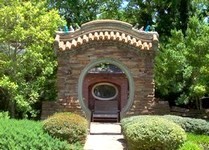
THE MOON GATE
Built in 1949
The design of the moon gate is interesting. To me, it looks like a large keyhole. It is really set up to reflect the moon’s movement. Notice the figures above the moon gate, the glaze is original and has never been “touched-up.” These were painted and glazed by Douglas Chandor in 1949. The figures on top ward off evil spirits and bring good luck and include, from the outside in, pairs of dragons, dogs, fish (white figures) and Chi-Lings. The curl-like symbols at the bottom on each side are the wan or 10,000 symbol.
MINIATURE GROTTO WINDOW DIORAMA
This is to be like you are inside looking out
As you enter through the moon gate, notice the grotto directly in front of you that Douglas designed. It is a three dimensional Chinese lake and fishing village with marbles, cypress knees, etc. making up the scene (it is a diorama built into the wall). It was built to take advantage of the natural light and the best time to see this is at noon on a sunny day.
Douglas constructed the wooden door to the right of the grotto so the children of the neighborhood could enter the garden to play. Before this was constructed, they were inclined to climb the brick walls. He did not mind the children coming into the gardens, as long as they did not destroy anything. His main concern was with their safety thus the door to “The Secret Garden” was added so they could always walk in and run and play. When he was alive, it was not locked. Douglas and Ina never had children but he was a gentle man who loved having them enjoy his garden.
KUAN YIN WALKWAY
Kuan Yin is in fact a Bodhisattva
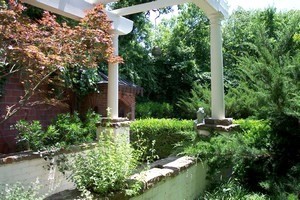
This statue is not original to the gardens but was given to the Bradfords for their anniversary by the crew that worked on the restoration of the gardens. It was purchased from an antique dealer and presented to the Bradfords. This shows what type of employers they were to be respected to this extent by their employees.
MOUNT COX
Finished in 1952
Many of Douglas’ subjects had their portraits painted at White Shadows, now Chandor Gardens. One of his subjects was James E. Cox, Governor of Ohio. While Governor Cox was here, he and Douglas became fast friends. Douglas told Governor Cox of his dream to build a mountain but felt he did not have the sufficient funds at that time to build it. When Governor Cox returned to Ohio, he mailed a letter with a check and said, “Build your mountain, fulfill your dream.” It was quite a feat, there are boulders weighing over 15 tons in the chandor-gardens-cox-mtmountain. Douglas handpicked each boulder and rock from Palo Pinto County, the neighboring county to the west. Douglas would go out to various ranches and ask the owners if they would like to be rid of their rocks and of course, if you know anything about ranching, rocks are what they don’t want on their places. Douglas supervised the entire construction of the mountain. He was indeed a very busy and talented man. He named the Mountain, Mount Cox after the Governor, there is an inscription on the third step from the top “Mt. Cox.”
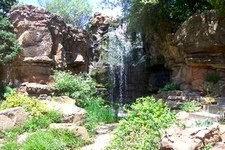
This statue is not original to the gardens but was given to the Bradfords for their anniversary by the crew that worked on the restoration of the gardens. It was purchased from an antique dealer and presented to the Bradfords. This shows what type of employers they were to be respected to this extent by their employees.

To recognize the power of the peace in the garden and to use the universal language of the garden to promote peace in the world.
To encourage individuals in many lands to share peace in the garden and to support peace in the world.
For peace on earth.
THE TRELLIS POND
The large center pond was covered with wisteria. The old wisteria was removed and replanted with a less invasive type. Wisteria is a main planting in Chinese scholar gardens; mostly in overhead forms so that the petals rain down on poets and scholars as they sit in the gardens.
The “stepping stones” are old millstones. The Chinese used materials they had used before as crossways over their water ponds. The Chinese were the original recyclers and Douglas carried on this tradition throughout the gardens. The pebbles, etc. that are in the cement blocks are in the shape of sea creatures. As you walk around the bend of the center pond, you will see large rocks towering over the water. Douglas sculpted these large rocks. The rock sculptors are known as mythical gods. One is an image of a seahorse and another is an image of a sea turtle, camel and bear. Across the way is a hand carved Chinese junk. Large rocks at the north end of the large center pond are an instructor (scholar) standing over a student. Notice the koi fish in this pond.
LARGE SCHOLAR ROCK-STONE OF THE IMMORTALS
Stone of the Immortals (Symbol of luck and protection for the garden)
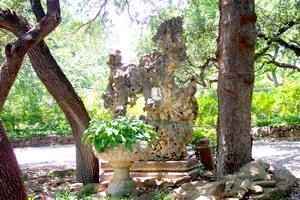
THE WHITE CHINESE BRIDGE
Spans a canal that is home to many beautiful fish
The statue you see to the side of the bridge is of St. Jude, the patron saint of hopeless causes. It seems to fit in this garden; it must have seemed at times to be a hopeless cause to the Bradfords. We are lucky they were determined to bring this jewel back to life.
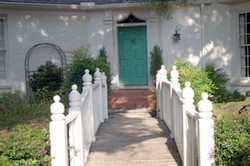
To designate and develop the garden as a place for meditation and a symbol for peace through the world.
To recognize the power of the peace in the garden and to use the universal language of the garden to promote peace in the world.
To encourage individuals in many lands to share peace in the garden and to support peace in the world.
For peace on earth.
The combination of these three symbols is very common at entrances to homes in China (where they are normally in the order Fu, Lu, Shou)
The background pattern is created entirely from repeating a reverse swastika pattern, which is the Chinese symbol for Wan, which means 10,000. Also good fortune and longevity, very commonly used for over 2000 years in China to mark thresholds and doors, this symbol is also commonly seen as the symbol for Buddha’s heart.
The White Chinese Bridge is original to the gardens; it has been refurbished but is original. It leads to the front door of the Chandor home. The Chinese feel the color of water adds to the meaning of a garden.
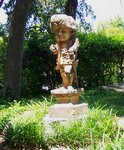
This was original to the gardens. There were two of them at one time but one disintegrated when they were trying to move it. Douglas had them placed at the end of the bowling green. What would this symbolize in this garden?
Hints:
• this garden was designed by an Englishman, it seems like a magical garden, it has a bowling green
• Lewis C. Carroll …..the statue is holding a tea strainer over his eye…it is the Mad Hatter from “Alice Through the Looking Glass.” This could truly be called Alice’s Wonderland.”
As you walk through this area to the bowling green, notice how the garden forms rooms. The plantings give you the feeling of walls around you. This way you cannot see the entire garden from one area. You must walk and explore each room or area as you walk through the ‘‘halls.’’ See how when you emerge from this “hall” the Lawn Bowling Green opens before you.
LAWN BOWLING GREEN
Built in the 1940s
chandor-gardens-gazeboHere again is the English influence of this garden, the Lawn Bowling Green constructed by Douglas. This has been an area for lawn bowling and at one time was a dump. It is a beautiful area with several rooms around it we will explore. At the end of it is the Pixie Pond and fountain, another bow to English influence. It is thought to be a necessity for an English garden to have a pixie ring to guard the magic. The magic here is the fountain coming up from the center. These little pixies are original to the gardens.
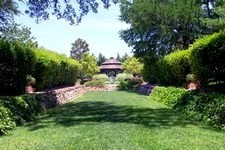
THE GAZEBO
This is not original to the garden but was in Douglas’ plans. Again, the Bradfords brought a dream of his to life. A rose garden was planted around the gazebo in 2009. To the west you will see the undeveloped acres and over the fence was Douglas’ dump for extra rocks, bricks, plants, etc. That is why many plants are growing there that truly are not native to this area. It seems even many of the cast-off plants decided to grow and add to the beauty of this once barren acreage.
THE EUROPEAN BOXWOOD GARDEN, THE WALLED AREA & THE FISH FOUNTAIN
Boxwood Garden planted in the late 1930s
The tall boxwoods are the European Boxwood and are not sold in nurseries in this area. They are grown with great success in areas such as Mississippi, Williamsburg, Virginia and Oregon but are very rare in Texas. These are over seventy-year old boxwoods and we are happy they are growing here in the gardens.
Notice the unusual brick pattern on the flooring. Although the brick pattern is in the shape of a fish, the whole thing is actually a fish face and mouth turned upward, the two slabs topped by six-point stars are eyes. The bricks that are standing upright are the fins. Fish signify wealth and good fortune. See the pieces of bricks Douglas used. It seemed sometimes he broke entire bricks to see what design he could make. It is almost like he never saw a brick he didn’t want to break to make it do his will. The Bradfords added the fish in the fountain. The fountain was constructed using a large tractor gear for the base.
In this room, you will see a casting of the famous ‘Cantoria” by Florentine sculptor Luca della Robbia (1400?-1482). We know it must have been important to Douglas because of the place of prominence it was given. He could look out the window of his studio and see this relief. The large window you see here is to Douglas’ studio. The eleven foot studio window provided Chandor with exposure to the north light.
He placed the windows to give the best light for painting. The trees have now grown and much more shade is produced. There are other windows around the other side of the house that opened to his studio. Known as one of the finest portrait artist of him time, he loved his gardens and painted to support them.
The relief in the wall is an Italian Renaissance; it seems to be of a festival. We do not know the story behind this relief but know it must have been important to Douglas because of the place of prominence it was given. He could look out the window of his studio and see this relief. The large window you see here is to Douglas’ studio. He placed the windows to give the best light for painting. The trees have now grown and much more shade is produced. There are other windows around the other side of the house that opened to his studio. Known as one of the finest portrait artist of him time, he loved his gardens and painted to support them.
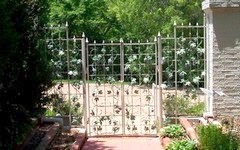
Another room off the bowling green contains the grape gates and they have a great story. Douglas had a friend, Vincent Bendix who lived in a penthouse in New York. Vincent had these beautiful gates hanging on the wall in his penthouse and one time while visiting, Douglas told him that is not where those gates belong, they belong in a garden preferably his garden. Douglas returned home and received a wonderful surprise shipment from his generous friend, Vincent. The inscription at the bottom and in front of the gates: “Good ole Vincent, here are your windows.” Notice the beautiful detail on the gates; they are truly a work of art.
The flooring here is not original to the gardens, the original one had become so uneven that it was dangerous for the public to walk on and was replaced. The pineapple is a symbol of welcome and was added by the Bradfords.
PATH AROUND THE CHANDOR HOUSE, THE ISLAND AND THE SOUTH PORCH OF THE HOUSE
House and path built in 1939
This Palladian style home was designed by the architect Joseph Pelich primarily to be Chandor’s studio. Additions to the home were built in the 1940s and once again after Douglas’ death in the 1950s.
To the left of the house’s front door and the Ming Bridge, is a small dock. Douglas kept a very small boat docked at this spot. As with some gardens, you can start a leaf at the top of this stream and eventually it will wonder around and find itself at the bottom of the stream.
The lovely island in this stream is the home of European Boxwood planted by Douglas. The bronze figure of a woman is original to the gardens but at one time was in the fish fountain in the boxwood garden area. A former employee and friend (Louie Welch) who had been in the gardens helping Douglas step-by-step was given the statue as a gift and when he died; his grandson returned it to the garden. He said he knew his grandfather would have wanted it to grace the garden as it had in the past. Notice the beautiful koi fish in this stream.
Around the path you will see the side porch of the house. Notice Dragon figure on south chimney over porch facing the triple tier fountain. Notice the number of claws is five for royalty and three or four are for everyone else. His tail is cloud shaped a symbol for luck.
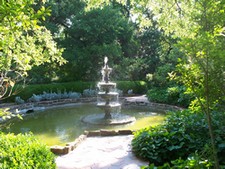
TRIPLE FOUNTAIN AREA
Fountain is made of copper
chandor-gardens-triple-fountainThis is another fountain the Bradfords brought to life, it was here but they made it work and it gives a wonderful sound as the water cascades down. The property has two water wells to feed the fountains and stream and the water features are made to recycle the water. Notice behind the fountain one of the many benches or resting areas located in the gardens, you truly should stop along the way, rest and enjoy the beauty around you. Be careful if you ever decide to go down the steps on either side of the triple fountain, the steps are steep and often very slick.
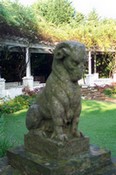
COURTYARD AREA
chandor-gardens-ramThe entrance into this garden is guarded by cast stone rams atop pillars; original to the gardens.
This was Douglas’ Silver Garden. All the plantings had a gray or silvery hue through gray and silver leaves. The Italianate pergola is original to the gardens and has been repaired and lends a wonderful frame to this area on one side with the house on the other. The Roman numerals in the cement on the patio show the date MCML (1950); the date this area was completed. Douglas looked at the garden as a canvas and here the artist mind set shows, date your work. A massive cedar elm tree provides shade to most of the courtyard and an astrolabe fountain in the center is the hub of four walkways.
The building you see behind the patio is the garage the Bradfords built. Douglas did not want cars in his garden and did not build a garage for that reason. Ina had to park her car in a garage on the property that belonged to her parents. Later you will see the gate that goes nowhere. It goes nowhere now but at one time that was the gate you went through to get to the garage and Ina’s car. The Bradfords were very careful to make all new construction blend in and appear to be original to the gardens.
INA’S WALK AND THE CAVE GROTTO
Built in 1936
Pass by the cutting garden and turn left to the walkway in front of the tool shed and the potting shed (now bathrooms). There is an inscription on the walkway that is Latin. Translation: MAY THIS LITTLE GARDEN FLOURISH CONSECRATED TO INA IN THE YEAR OF OUR LORD, EDWARD THE EIGHT, FOREVER MORE..
The white bricks start a new word. Douglas made this walk in honor of his beloved wife, Ina. Here again the English influence shows in reference to Edward the Eighth, who abdicated his throne for the American divorcee Wally Simpson. The walkway was built in 1936 and was the beginning of Douglas’ garden.
At the end of this walkway, you will see the “gate that goes nowhere.” This is the one that led to the garage and Ina’s automobile.
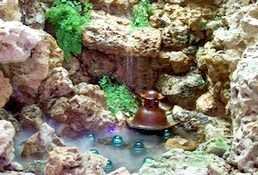
THE CAVE GROTTO
This grotto is like you are outside looking in chandor-gardens-grotto Walk on Ina’s walkway then take a right to the Cave Grotto. The entire grotto is original except for the bamboo. Note the date on the bench, 1951, the year it was completed. Douglas wanted this to be an area to rest and reflect on things around you. Chuck Bradford designed the bamboo backdrop and had vines added to eventually cover the top. Maybe he wanted this for privacy because his office was the building behind it. Bamboo is used extensively
Notice the two kissing toads: It is said to rub the tummy of the toads, for luck. Toads are placed on each side of doorways or pathways to bring good fortune and money. Usually there is a coin in each toad’s mouth, and coins are left at the bases of the statues so others will leave coins as they pass and the fortune increases.
Look toward the Chi-Ling fountain and notice out how truly symmetrical the gardens are. You can see the Moon Gate and beyond it to the fishing village scene. The meandering nature of the layout of the garden follows the Chinese belief that evil spirits will follow you if you walk in a straight path.
Notice the two Fu Dogs (Fu Lions) at the entrance to this walkway. One is a female and the other is a male. The female has a pup at her feet and the male has a ball.

WALKWAY TO THE CHI-LING FOUNTAIN, AROUND THE POND AND THE HAPPY BUDDHA IN NICHE
The crepe myrtles on each side of the walk to the fountain were planted by the Bradfords (planted in late 1990s), note how large they are and notice the English knot garden of dwarf yaupon hollies around them.
Notice the niche with the statue of Buddha that is surrounded by marbles. This is Happy Buddha, a fixture in most Chinese gardens. The rock shapes over his head and on each side are unopened lotus blooms, which represent potential for enlightenment.
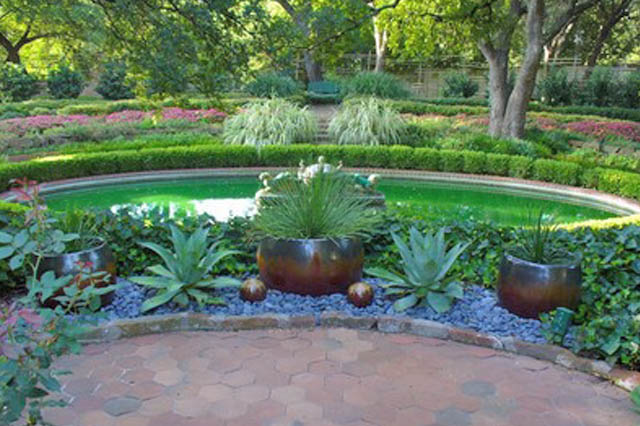
Constructed in the 1940s. (Chi-Lings found in New York City)
The original Chi-Lings are in the house. To preserve them; they were refurbished and are being kept in the foyer. The ones you see are replicas.
Douglas contributed to making this beautiful fountain fired and glazed it. The Chi-Ling is a commonly used Feng Shui guardian animal. Chi-Ling has many legends, stories, and a long history. There is evidence of Chi-Ling found during the Hun dynasties (100 BC). The most common thread found in all of the stories about the Chi-Ling is that it was used for protection. When emperors and generals were fighting, they would use the symbol in sculpture, on their armor and on their
uniforms. After they did so, they were able to conquer and protect themselves. The symbol has been used on palace doors and palace rooftops, rooms used by the emperor and on their crowns, jewelry and clothing. Thus, they are called “immortal animals” or “animals of god” creatures. In the Western world and in Greek mythology there are very similar guardian animals such as the unicorn, Pegasus, the chimera, the griffin, forest spirits and gargoyles protecting buildings. The Chi-Ling is a combination of the three strongest animals. It has the horns and scales (armor) of a dragon; the head of a lion; and the body shape of a horse. They usually come in sets of two or three.
Notes:
This is information on the Chi-Lings that have been located in the house for their protection. The Chinese characters on the Chi-Ling give the information of their creation, reading from right to left, the figures were created on “a good day” in June of the 15th year of the Emperor Jia Jing (1796-1821) which would be 1811, then the ceramic process used which was lioli (traditional green ceramic Chinese tile), then the signature of the maker, last name first, Lee, remainder of signature unreadable. She insisted she felt it was possible they are that old, but we are doubtful. Think maybe Douglas had someone paint the characters on there. The golden fish on top also signify luck and wealth.
Around the bottom, near the water, are coke bottles and then a little higher are 7-Up bottles, Douglas used these for color and light. It is also beautiful at night with the lights in the fountain on because it gives an interesting design on the water in the pond. This fountain shoots water 20 feet into the air. He also used marbles here. (The Chinese invented marble and Douglas used them throughout the garden).
By the time you have gone through the entire garden, it is hard to believe you have only covered 3½ acres. It seems like the garden is much larger.
There are three types of gardens in China: royal, sacred (monks or Zen), and scholar. Chandor Garden is a scholar garden.
All the large rocks resemble rocks of similar shapes and color used throughout a scholar garden in Suzhou, China, The Lingering Garden (Liu Yuan), built during the Ming dynasty in the 1500’s. These gardens also contain a mountain, moon gate, and various overhead arbor structures.
